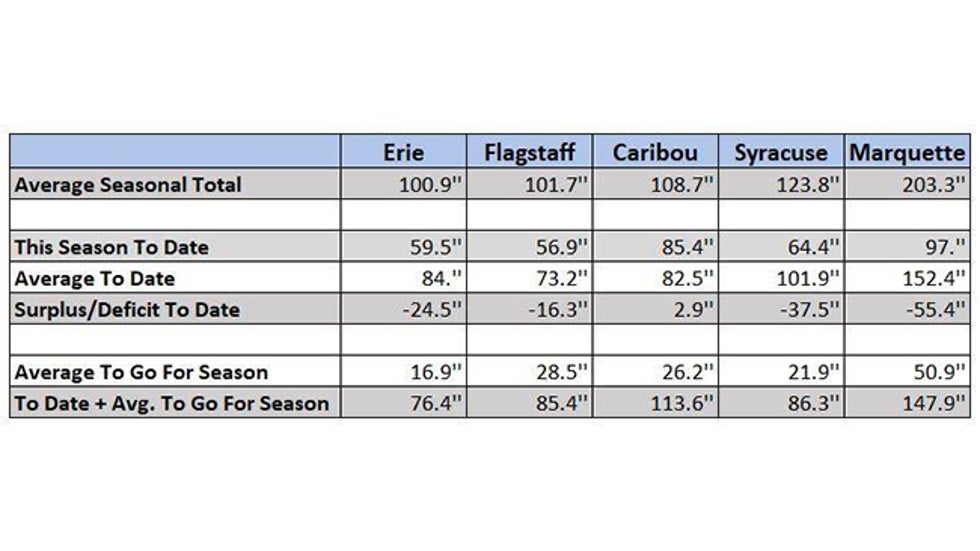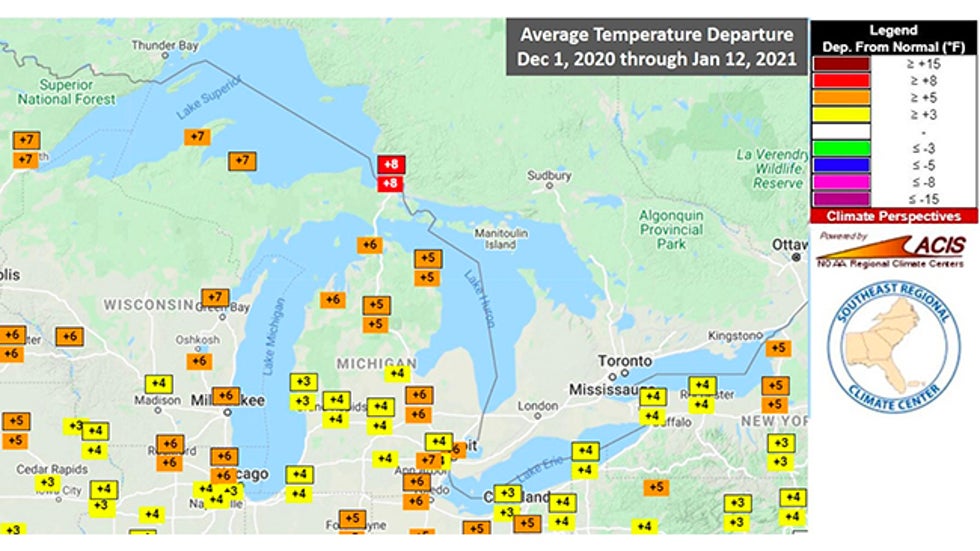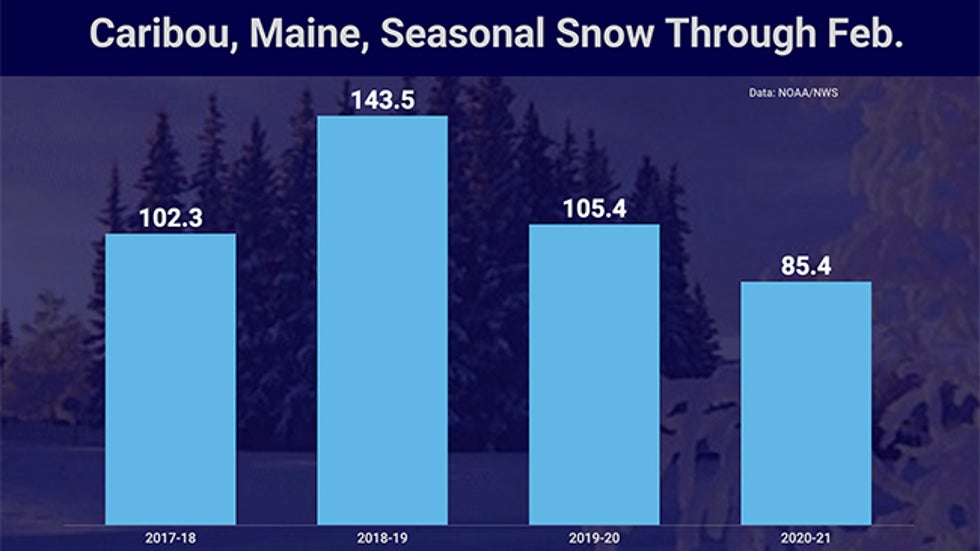Tom Niziol
 Three of the five locations that are members of the 100-inch club are found in the Great Lakes region, noted for those lake-effect snowstorms. This map shows the departure from average snowfall from October 2020 through February 2021.
Three of the five locations that are members of the 100-inch club are found in the Great Lakes region, noted for those lake-effect snowstorms. This map shows the departure from average snowfall from October 2020 through February 2021.There are cities that have reputations for bad weather. They include an elite club of sorts for locations that receive 100 inches of snow or more each winter, known as the “100-Inch Club.”
The notorious list includes places like Erie, Pennsylvania; Flagstaff, Arizona; Caribou, Maine; Syracuse, New York; and Marquette, Michigan.
But that's not holding in many of these cities so far this winter.
Through the end of February, none of these cities have hit the 100-inch mark and it is somewhat unlikely that the majority of them will get to that milestone this year.
 Snowfall statistics for the five "100-inch club" cities through Feb. 28.
Snowfall statistics for the five "100-inch club" cities through Feb. 28.Through Feb. 28, only one of the five locations, Caribou, is above average for snowfall and only by a measly 2.9 inches.
The other locations are all at least a foot below average. Syracuse and Marquette are over 3 feet and 4.5 feet below average, respectively.
To answer the question of just why these cities are multiple feet behind their normal winter pace, one has to first look at their location.
Three of the five locations are in the Great Lakes region, notorious for heavy lake-effect snowstorms.
In fact, a quick look at the accumulated snowfall departures from Oct. 1, 2020, through Feb. 28, 2021, around the Great Lakes in the map atop this article mimics the snowbelt locations downwind of each lake.
Lake-effect snow occurs when cold air crosses the relatively warm waters of the Great Lakes.
Cities like Marquette, Erie and Syracuse get as much as 70% of their seasonal snow from these localized snowstorms.
SPONSORED: Sale on Patagonia at Paragon Sports
But if there isn’t any cold air crossing the lakes, you don’t get lake-effect snow.
As of mid-January, the Great Lakes region as a whole was running anywhere from 3 to 8 degrees warmer than average and lake-effect snow was hard to find.
 The temperature departure across the Great Lakes region from December through mid-January was 3 to 8 degrees warmer than average.
The temperature departure across the Great Lakes region from December through mid-January was 3 to 8 degrees warmer than average.To be clear, it's not as if there isn't any snow on the ground in most of these locations.
Marquette, Michigan, reported a 22-inch snowpack as of the morning of March 1, which is fairly typical for this time of year.
Caribou is the northernmost city in the continental U.S. Because they get so cold and are often within the storm track for many of the major weather systems that cross the U.S. each winter, they usually top out over 100 inches of snowfall.
I have to admit, they are at least trying to live up to their reputation with a snowfall surplus of 2.9 inches right now. They just had a top-10 snowy February, picking up over 3 feet of snow, according to the National Weather Service.
However, when compared to their last three abundant snowfall winters, they have seen decidedly less snowfall.
 Snowfall through February for the past three seasons compared to the current season reveals that Caribou, Maine, is bucking a recent trend for much snowier winters this season.
Snowfall through February for the past three seasons compared to the current season reveals that Caribou, Maine, is bucking a recent trend for much snowier winters this season.Finally, you have to go west to the higher elevations of far northern Arizona to get to our last elite member of the 100-inch club.
Flagstaff, Arizona, has a particular feature that brings abundant snowfall that the other cities do not – elevation.
Flagstaff sits at an elevation of about 7,000 feet, nearly 2,000 feet higher than Denver. That elevation ensures they are cold enough through much of the winter season, despite their southern location, to get precipitation in the form of snow.
After starting out pretty slow this season, with only 3.1 inches of snow through mid-January, Flagstaff hit the snowfall jackpot. During a very active storm track through the Southwest, the city tallied up 43.5 inches of snowfall in only a 10-day stretch in late January.
But they were quite dry in February, leading to a monthly snowfall deficit of 14.9 inches of snow, stopping them in their “not so snowy” tracks toward the coveted 100-inch season.
There is still a lot of ground to cover before the warm breezes relinquish all hopes for snow for the rest of the season.
However, over the next five days, even Marquette, which sits at 97 inches of snow so far this season, will be hard-pressed to reach their goal.
Only time will tell who gets to keep the 100-inch club snowfall card into next winter.
The Weather Company’s primary journalistic mission is to report on breaking weather news, the environment and the importance of science to our lives. This story does not necessarily represent the position of our parent company, IBM.
The Weather Company’s primary journalistic mission is to report on breaking weather news, the environment and the importance of science to our lives. This story does not necessarily represent the position of our parent company, IBM.

No comments:
Post a Comment